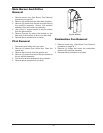
33
7<9.,=287 ;8,.->;.<
Inspect on the first and third month after initial startup
and then on an annual basis. If problems are found,
refer to the Troubleshooting sections of this manual for
additional directions.
1. Remove top of heater and inspect heat exchanger
for soot and examine venting system.
2. Remove rear header and inspect for scale
deposits.
*3. Inspect pilot and main burner flame and firing rate.
*4. Inspect and operate all controls and gas valve.
*5. Visually inspect system for water leaks.
*6. a. Oil pump motor and bearing assembly, if oil
cups are provided.
b. Disconnect pump from header and check con-
dition of pump impeller. Check condition of bearing
by attempting to move impeller from side to side.
Replace any parts showing wear.
c. Check pump coupler for wear and vibration.
7. Check flow switch paddle.
8. Clean room air intake openings to ensure ade-
quate flow of combustion and ventilation air.
9. Keep heater area clear and free from combustible
materials, gasoline, and other flammable vapors
and liquids.
*Should be checked monthly. (Takes approximately
15 minutes).
'A
$"##
$
T
he Raytherm Low NOx Heater is offered with WH1-
On-Off firing (standard) or 2-stage firing (optional). The
heaters are certified and tested under the latest edition
of the ANSI Z21.10.3/CSA 4.3 standard for hot water
heaters. The heater should be installed to meet all
local codes, the National Fuel Gas Code ANSI Z223.1,
and the National Electrical Code, ANSI/NFPA 70-latest
edition.
9.;*=287
On call for heat, the ignition system, consisting of an
electronic spark module, gas pilot system is energized.
Providing pilot is proven, blower will start running, the
main gas valve will open and the heater will operate.
When the operating control is satisfied, the heater will
shut down.
#=*;=%9 ;8,.->;.<
#072=2878->5.
1. Turn on power to the heater with gas supply off.
2. Check ignition module as follows:
a. Set the tankstat to call for heat.
b. Watch for continuous spark at the pilot burner.
%$ Combustion air must not be
contaminated by corrosive chemical fumes which
can damage the heater and void the warranty.
Fig. 32: Pilot Burner Flame—IID (Atmospheric Models)
SEE DETAIL VIEW A
DETAIL A
Fig. 33: Burner Detail


















